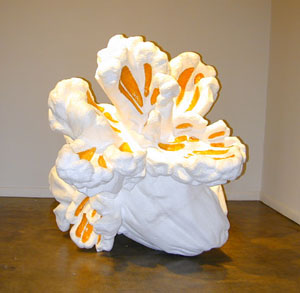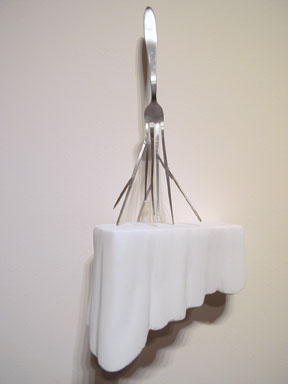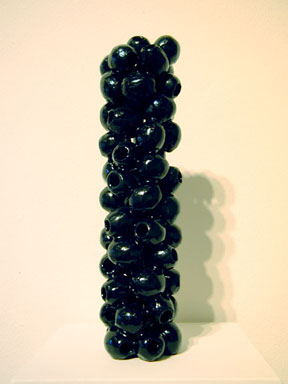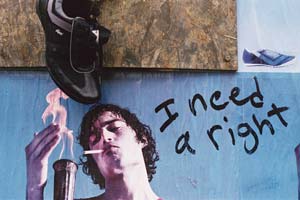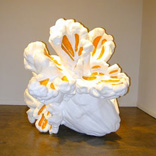December 6 — San Antonio The next two weeks will be a study in cultural dichotomies. I am set to travel from Art Basel Miami Beach directly to the 2006 Cairo Biennial — from the birthplace of the T-back to the cradle of civilization.
In the immortal words of Hunter S. Thompson, there is no way to pack for this trip.
December 7-10 — Miami Beach
Attendance is staggering — some 40,000 people. Equally staggering are the number of familiar faces, and each one looks as glazed as mine, thanks to a constant onslaught of visual and social stimuli. Despite obscene chunks of change bandied about at the main event, there is palpable desperation in the air, not unlike the feeling of a roadside watering hole at closing time. We are trapped in a time/space anomaly, reliving the eighties right before the boil burst … Reaganomics Part Deux — or is it Part Duh . This seems fitting in the wake of Pinochet's passing.
Small peripheral fairs (Aqua, NADA, Scope) and offsite openings, including an exceptional show at Lemon Sky Projects, offer respite: fresh talent, chatty and genuinely friendly gallerists, artists who still enjoy talking about their work. But a major art fair is no place for a cynic unless you really enjoy free drinks. Forget high art. This is South X Southwest. I give up and 'go with the flow,' spending my last waking hours in Miami on a barstool watching a parade of German gallery assistants schmooze the ponce lush next to me because they think he is Keith Richards.
December 10 — London to Cairo
In 'Do you feel it? Art, utopia and the real'( Artlies , no. 41), Lars Bang Larsen described airports as 'utopian transits.' I'd like to print that phrase out, cut the letters apart and make him wear it through security — a walking anagram, a letter bomb, if you will — punishment for what can only be an optimism that borders on psychosis at this precise moment in history.
December 11 — Cairo
My flight arrives late. Luckily, a driver is still waiting to take me downtown because I am on a U.S. Embassy roster of some sort. This is serious business. The Semiramis, our state-sanctioned lodging, is one of many architectural throwbacks to Egypt's socialist era. It looks like a combination of the Kremlin's back offices and the Galleria. Handsome, self-conscious bellhops dressed in red and yellow costumes that resemble organ grinder monkey suits complete with matching fezes greet you at the entrance — deplorable, yes, but in a wholly different way from Miami Beach. I run into fellow 'delegate' Domenick Ammirati (senior editor, Modern Painters) in the hotel lobby. We buy each other thimble-sized shots of scotch in the Semiramis' Ambassador's Club. My room, located at the end of an alarmingly Shining -like hallway, has an amazing view of the Nile.
I sleep like the dead.
December 12 — Cairo
Domenick, NYC-based artist and writer Judith Barry, Leanne Mella who is the visual arts program specialist with the U.S. State Department, Miami-based artist and critic Gean Moreno, American Pavilion curator Gilbert Vicario of the Museum of Fine Arts, Houston, and I meet as a group the next morning. Biennial participant Daniel Joseph Martinez and his assistant Peter Clarke are still tweaking Daniel's piece for its opening night performance. Domenick, Gean and I decide to go walkabout till opening time. We set out for the market on foot.
The pace and density of Cairo remind me of Mexico City, yet this place seems less dangerous, especially when attempting to cross the street. Major difference: no one pays attention to traffic signals in either city, but these people won't run you over. Good to know. There also seems to be more phenotypic diversity in Cairo than Mexico. After all, this region has been invaded by just about everyone at some point in history . It gives the city a sense of plurality, however superficial — a somewhat cosmopolitan vibe despite widespread poverty and ubiquitous machinegun-toting soldiers.
Inner Cairo is a labyrinth of disintegrating stairways and alleys, tea shops, colonial palaces, mosques, churches, temples, ancient cobblestones and active archeological digs, all swarming with people. We climb an old defensive structure — a city gate built under the reign of Alexander the Great — as the afternoon call to prayer begins. The sound rebounds like a beautiful, organic call and response. A hundred feet below, capillaries of human traffic continue to flow unabated. In a place like this, one could easily get lost on purpose.
Daniel's gallerist, Christian Haye of The Project, arrives and the group departs for the Biennial. The exhibition, spread over three venues, reads like a starving artists' garage sale, with very few exceptions. There is little consistency save for what appears to be an anomalous fetish for dispassionate still-life paintings. The old guard is definitely in control of this operation.
The most popular work turns out to be Daniel's animatronic doppelganger. People crowd around the piece as it cycles from a state of deathlike inertia into hyperbolic convulsions … limbs flailing, pounding and scraping the floor. Violent thuds reverberate throughout the museum. Some marvel at the eloquent mechanics of the robot. Others are genuinely disturbed by it. They cover their eyes but peek through their fingers as if reluctantly witnessing the climactic moment of a slasher film. Daniel's commingling of ecstasy and death is, of course, intentional and cerebral — Bataille's abstractions artfully distilled to their unnerving essence — but the work transcends theoretical reference and footnote. It functions on a visceral, universal level, its power constantly reinforced and refueled by the crowd's varied reactions.
December 13 — Cairo
Next up is a pleasantly bizarre trip in an armored vehicle to a low-key luncheon with a group of embassy folk, Cairo-based journalists and artists, some of whom later present their work at the Townhouse Gallery that evening.
Founded by William Wells, Townhouse functions like a combination of DiverseWorks and Artpace — part classic Kunsthalle, part residency program. This multi-venue facility, nestled in a low-rent industrial/residential hood in central Cairo, is the unquestionable foundation of Egypt's contemporary art scene. We are introduced to the work of Doa Aly, Osama Dawod, Khaled Hafez and Basim Magdy, among others. (Basim curated Threat Zone at TPS in San Antonio in 2005 and will be exhibiting at Okay Mountain in Austin this spring, thanks to curator Regine Basha.) This group seems somewhat insular; generational lines are distinct in terms of both attitude and output, but this is ultimately exculpatory considering the small size of Cairo's contemporary art community.
In Townhouse's galleries, The Maghreb Connection: Movements of Life Across North Africa, curated by video artist Ursula Biemann, explores the EU-fueled militarization of the borders of the Mediterranean countries west of Cairo — Algeria, Libya, Morocco and Tunisia. It is impossible not to draw an immediate parallel with the escalating fortification of the U.S.-Mexico border: its absurdity, hypocrisy and inevitably tragic human consequences. This show really should travel. I think I ate pigeon at lunch. Just the thought of it makes my stomach turn for no good reason.
December14 — Alexandria
Domenick, Gean and I experience a collective cerebral regression. We debate the physics of hurling beer bottles into the Nile till sunrise. This is completely retarded, especially considering our pending 9 AM departure. The group piles into another bulletproof van with diplomatic plates for the four-hour journey to Alexandria. I feel conspicuous. I suspect our assigned bodyguard is narcoleptic. This combination makes me positively cagey.
One must pass through the slums to leave Cairo. Row after row of prison-like tenements could be mistaken for low-income housing anywhere — Beirut, Chicago, Harlem, Moscow — if it weren't for the telltale frequency of camels, hitchhiking Bedouin and the pyramids in the distance. Though they are mere meters from the freeway, the morning smog is so thick that the pyramids are almost invisible. (I use the term 'freeway' rather loosely; there are checkpoints every few miles. We are, of course, exempt.)
The desert apparently turns all roads into carnival rides — an effect amplified by the dead weight of our ridiculous carriage with its dearth of shock absorbers. Gentle bumps lull you to sleep then, WHACK, your head hits the roof, triple-paned bulletproof glass or both … so much for catching up on sleep. But Alexandria, with its resort town feel and Mediterranean vista, is well worth the ride. Despite a population of some three million, it feels downright quaint compared to Cairo.
We arrive and are soon whisked off to a presentation by the Alexandria Contemporary Art Forum. Founded by artist Mona Marzouk and critic and curator Bassam El-Baroni, the ACAF is a decidedly grassroots effort that includes an exhibition space, residency, and educational and public art programs. Much of the work presented is youthful and unresolved but not without promise. Most intriguing is Mahmoud Khaled, with his parody of the government's attempt to categorize people along ethnic and religious lines and to track and control their movement. Khaled's project included procuring multiple identification cards, each assigning him a different ethnic and religious profile — highly illegal and ballsy, to say the least. Overall, this community is warm, tight and unpretentious, which reminds me of home, but I'm starting to feel truly unwell.
December 15 — Cairo
We arrive back in Cairo the following evening just in time for a ride down the Nile at sunset. Artist Dennis Balk shows up and joins us for a goodbye dinner (Gean, Judith and Leanne all have morning flights). Domenick drops his wallet in the cab on the way home. Three words: Dennis Balk rocks. Within seconds, he's hailed another vehicle. We jump in, Dennis waving and shouting, 'Follow that cab.' The driver doesn't understand English and quite obviously thinks we're lunatics. Every other car on the road is a cab and they all look exactly alike . Our flailing and pointing would be construed as idiocy in any language. Fucking priceless.
December 16-17 — Cairo
Domenick and I are the last to leave Cairo. We have a leisurely dinner with Basim and Doa (though I am now too sick to eat), followed by a stint at the After Eight Club. This place is straight out of a William S. Burroughs novel — the kind of joint where ex-operatives go to score dope or drink themselves to death on watered down whiskey, and there are a fair number of potential candidates present. I try not to think about the band, which is perhaps the worst lounge act I've ever heard and that says a lot. Instead, I think about Cairo and the Maghreb — as a place instead of an abstraction — and about pre-colonial porosity, fluidity, hybridity. I then take a long, panoramic look around the After Eight Club. The joint does not make a strong case for globalization, but somehow this doesn't seem self-contradictory. I think about the knot in my gut and try to embrace the sensation. This isn't West Nile Virus; it's Nile fever. Maybe I just need more time…
Anjali Gupta is the editor of Artlies.


